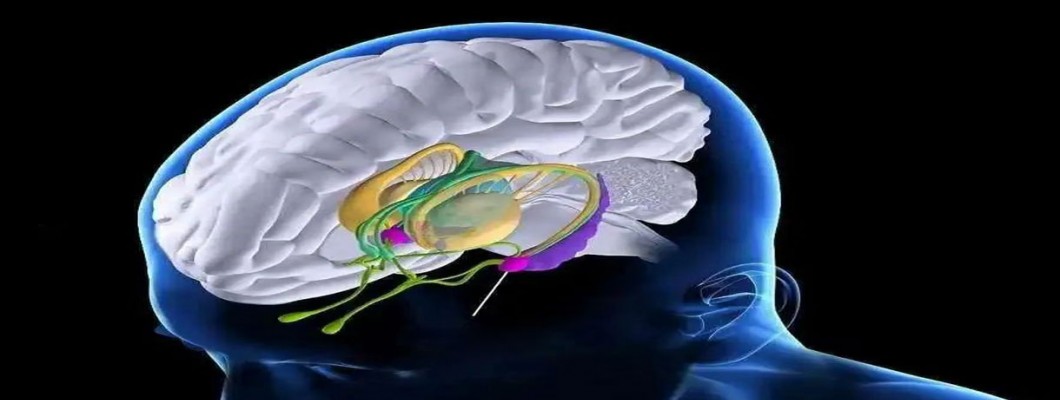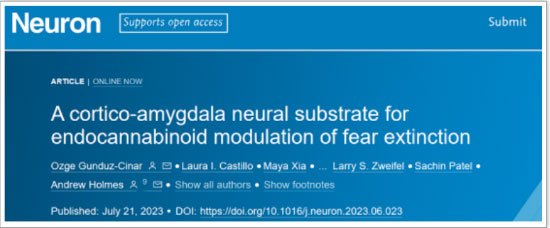
Neuron, a top neuroscience journal: new neural mechanisms by which endogenous cannabinoids regulate fear memory extinction.
A growing body of literature suggests that endogenous cannabinoids (eCBs) can promote memory extinction, making them potential therapeutic targets for extinction-deficient disorders, including anxiety disorders and post-traumatic stress disorder (PTSD) . However, despite the great interest in the extinction-mediated effects of eCBs, the neural circuitry underlying these behaviours is unclear.
The amygdala is an area of the brain under neuromodulatory control that is critical to the extinction of fear. Previous studies have shown that eCB levels in the basolateral nucleus of the amygdala (BLA) in rodents are elevated following fear extinction. Recent studies have further shown that neurons in the rodent mPFC (specifically the ventral medial PFC [vmPFC]/submarginal cortex) direct memory extinction through inputs to the BLA and neighbouring structures. direct memory extinction.
Recently, Professor Andrew Holmes and Ozge Gunduz-Cinar (first authors) of the National Institutes of Health and the National Institute on Alcoholism and Alcoholism published research in Neuron in which the team demonstrated that eCBs dynamically signal in mPFC/BLA neurons during fear extinction and contribute to memory extinction.

Neuron is one of the most important academic journals in the entire field of neuroscience.
1. Prefrontal-amygdala excitation promotes fear extinction and increases levels of BLA eCBs
After fear training followed by partial fear extinction training, the researchers found that light activation of the mPFC/BL A in the extinction extraction test species produced lower levels of freezing behaviour. Meanwhile, animals in the BLA that received partial dissipative training + light activation group had higher levels of arachidonic acid ethanolamine (AEA).
These preliminary data suggest that optogenetic stimulation of the mPFC-BLA promotes the formation of receding memories and leads to an increase in AEA levels in the BLA. And in combination with a CB1R antagonist (SR141716A, rimonabant), it was further shown that stimulation of mPFC axons in the BLA during extinction training mobilises BLA eCBs, which in turn facilitates extinction via CB1R-mediated signalling.
2. Dynamic signalling of prefrontal-amygdala eCBs during regression
In order to gain a clearer understanding of the temporal dynamics of eCBs signalling, researchers used a genetically encoded GPCR-activated eCB-based biosensor (GRABeCB2.0) to measure eCBs in mPFC/BL A neurons during animal extinction.The results revealed that, during training, the GRABeCB2.0 signals were increased in response to the US but not to the CS. Interestingly, during extinction training (50 trials), there was a slight decrease in GRABeCB2.0 signals during the CS turn-on period compared to the early (first 5 trials) extinction training, which was evident in the late (last 5 trials) period.
Most strikingly, there was a significant increase in GRABeCB2.0 signalling in the time period after CS closure. and relative to early extinction training, this CS closure-associated increase was attenuated in the late phase. the finding that GRABeCB2.0 signals increased during CS closure suggests that eCBs may be signalling in the mPFC/BLA to keep track of the expectation of electroconvulsive omissions during extinction-high in the early phase of extinction, low in the late phase. period, and low in the post-recession period.
3. eCB-CB1R signalling regulation prefrontal-amygdala synaptic neurotransmission
A key feature of eCBs is their ability to inhibit the presynaptic release of the neurotransmitter, glutamate, in mPFC neurons projecting to the BLA. The CB1R-mediated inhibition of mPFC/BLA synaptic glutamate release probability was found by electrophysiological recording of light-evoked excitatory postsynaptic currents (oEPSC) in BLA neurons. Secondly, activation of vmPFC/BLA synapses was also found to be was sufficient to cause an increase in BLA eCBs and produce a long-term depression (LTD) of glutamate release at mPFC/BLA A synapses.
4. CRISPR-Cas9 mutations Prefrontal-amygdala Cnr1 impairs memory fading
Finally, the researchers used CRISPR-Cas9 technology to selectively lose Cnr1 (cannabinoid receptor) in mPFC/BL A neurons. and confirmed that the CRISPR-Cas9 mutation resulted in a loss of CB1R-mediated inhibition of synaptic glutamate release in mPFC/BLA. From the On a behavioral level, Cnr1 mutant and control mice showed consistent behavioural effects during fear training and extinction, however, mutant mice showed significantly higher freezing levels in extinction recovery assays than controls, although this extinction impairment was transient and specific to the vmPFC/BLA pathway.
The present study provides an important new advance in our understanding of the neural substrates through which eCBs regulate fear extinction by their signalling. One of the key novel findings stems from GRABeCB2.0 biosensor recordings of eCBs.
In summary, this study proposes a novel model in which the engagement of mPFC/BLA neurons during fear extinction mobilises eCBs in the BLA, which in turn dynamically report to these neurons changes in CS-electroshock-associated learning expectations to support the embodiment of extinction memories. This provides an important basis for our understanding of the neural circuit mechanisms behind the pro-absorptive effects of eCBs, suggesting an important role for endogenous cannabinoids in the treatment of psychiatric disorders such as anxiety disorders and PTSD.

Leave a Comment